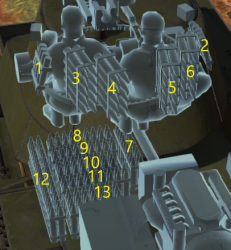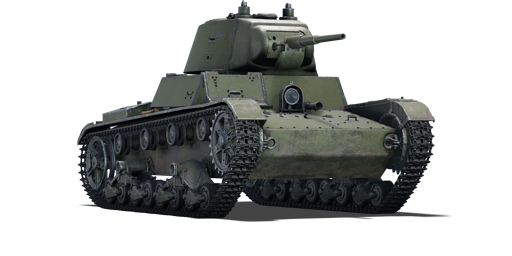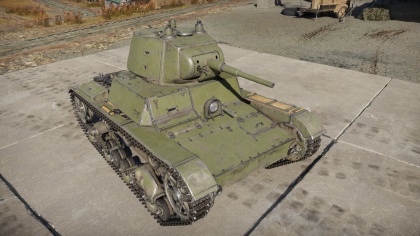Difference between revisions of "T-26 (China)"
(→Mobility) |
(→Survivability and armour) |
||
| Line 8: | Line 8: | ||
== General info == | == General info == | ||
| − | |||
=== Survivability and armour === | === Survivability and armour === | ||
<!--''Describe armour protection. Note the most well protected and key weak areas. Appreciate the layout of modules as well as the number and location of crew members. Is the level of armour protection sufficient, is the placement of modules helpful for survival in combat?'' | <!--''Describe armour protection. Note the most well protected and key weak areas. Appreciate the layout of modules as well as the number and location of crew members. Is the level of armour protection sufficient, is the placement of modules helpful for survival in combat?'' | ||
Revision as of 15:19, 1 March 2020
Contents
Description
The ␗T-26 mod. 1939 is a rank I Chinese light tank
with a battle rating of 1.0 (AB/RB/SB). It was introduced in Update 1.91 "Night Vision". It is identical to the Soviet T-26.
General info
Survivability and armour
This is definitively the worst characteristic of this vehicle; armour is flat and thin on all sides. Do not expose yourself to enemy fire. Crew placement is not lined up from the front, meaning shells without HE filler can take up to 3 shots before being destroyed. Beware of HMGs and autocannons, since they will be able to penetrate your armour.
Armour type:
- Rolled homogeneous armour
| Armour | Front | Sides | Rear | Roof |
|---|---|---|---|---|
| Hull | 15 mm (22°) Front plate 7 mm (64-80°) Front glacis 15 mm (6-52°) Lower glacis |
15 mm (21-23°) Top 15 mm (0°) Bottom |
15 mm (0°) Top 15 mm (12°) Bottom |
10 mm Hull 6 mm Rear |
| Turret | 15 mm (13-15°) Turret front 15 mm (5-44°) Gun mantlet |
15 mm (17-19°) | 15 mm (17°) | 10 mm |
Notes
- Suspension wheel is 10 mm thick while tracks are 15 mm thick.
- Belly armour is 6 mm thick.
Mobility
While being a light tank, its mobility is one of a medium. It will take you where you want to be, provided you choose your route well and avoid tricky manoeuvres. Reverse speed, while not great (-6 km/h), can save you from some bad situations, provided cover is not too far behind.
| Mobility characteristic | ||
|---|---|---|
| Weight (tons) | Add-on Armor weight (tons) |
Max speed (km/h) |
| 9.8 | N/A | 33 (AB) |
| 30 (RB/SB) | ||
| Engine power (horsepower) | ||
| Mode | Stock | Upgraded |
| Arcade | 141 | 174 |
| Realistic/Simulator | 80 | 91 |
| Power-to-weight ratio (hp/ton) | ||
| Mode | Stock | Upgraded |
| Arcade | 14.39 | 17.75 |
| Realistic/Simulator | 8.16 | 9.28 |
Armaments
Main armament
The 20-K is the typical Soviet rank 1 gun. Players should get used to it since it will be your main armament up until rank 2. This gun has a good amount of HE filler, meaning penetrating shells will do good damage, sometimes even one-shotting enemies. In longer ranges, shells begin to lose penetration and accuracy; it is not made for sniping. Try to bring ~10-15 BR-240SP (pure AP shells) for heavier targets. This gun is very forgiving to beginners, with its very fast reload speed and turret traverse.
| 45 mm 20-K | |||||
|---|---|---|---|---|---|
| Capacity | Vertical guidance |
Horizontal guidance |
Stabilizer | ||
| 205 | -5°/+28° | ±180° | N/A | ||
| Turret rotation speed (°/s) | |||||
| Mode | Stock | Upgraded | Prior + Full crew | Prior + Expert qualif. | Prior + Ace qualif. |
| Arcade | 9.50 | 13.20 | _.__ | _.__ | _.__ |
| Realistic | 9.50 | 11.20 | _.__ | _.__ | _.__ |
| Reloading rate (seconds) | |||||
| Stock | Prior + Full crew | Prior + Expert qualif. | Prior + Ace qualif. | ||
| 3.80 | _.__ | _.__ | _.__ | ||
Ammunition
| Penetration statistics | |||||||
|---|---|---|---|---|---|---|---|
| Ammunition | Type of warhead |
Penetration in mm @ 90° | |||||
| 10m | 100m | 500m | 1000m | 1500m | 2000m | ||
| BR-240 | APHEBC | 69 | 68 | 59 | 50 | 42 | 35 |
| BR-240SP | AP | 73 | 71 | 62 | 52 | 44 | 37 |
| Shell details | ||||||||||
|---|---|---|---|---|---|---|---|---|---|---|
| Ammunition | Type of warhead |
Velocity in m/s |
Projectile Mass in kg |
Fuse delay
in m: |
Fuse sensitivity
in mm: |
Explosive Mass in g (TNT equivalent): |
Normalization At 30° from horizontal: |
Ricochet: | ||
| 0% | 50% | 100% | ||||||||
| BR-240 | APHEBC | 760 | 1.4 | 1.2 | 15 | 32.3 | +4° | 48° | 63° | 71° |
| BR-240SP | AP | 757 | 1.4 | N/A | N/A | N/A | -1° | 47° | 60° | 65° |
Ammo racks

| Full ammo |
1st rack empty |
2nd rack empty |
3rd rack empty |
4th rack empty |
5th rack empty |
Visual discrepancy |
|---|---|---|---|---|---|---|
| 205 | 165 (+40) | 124 (+81) | 83 (+122) | 42 (+163) | 1 (+204) | Yes |
Turret empty: 124 (+81)
Machine guns
| 7.62 mm DT | ||||||
|---|---|---|---|---|---|---|
| Coaxial mount | ||||||
| Capacity (Belt capacity) | Fire rate (shots/minute) |
Vertical guidance |
Horizontal guidance | |||
| 1,890 (63) | 600 | N/A | N/A | |||
Usage in battles
Describe the tactics of playing in the vehicle, the features of using vehicles in the team and advice on tactics. Refrain from creating a "guide" - do not impose a single point of view but instead give the reader food for thought. Describe the most dangerous enemies and give recommendations on fighting them. If necessary, note the specifics of the game in different modes (AB, RB, SB).
Pros and cons
Pros:
- Gun has good penetration and great post-penetration damage for its rank
- Massive ammo capacity
- Fairly steady gun platform
Cons:
- Poor armour
- Only 3 crew members packed tightly together, survivability is not great
- Weak engine, mobility suffers on inclines
- Very poor reverse speed of only -3 kph
- Currently is completely identical to the Soviet T-26 (default camouflage is the same), indistinguishable in Simulator Battles unless the alternative camouflage is purchased
History
Development
The T-26 light tank design is derived from the British Vickers 6-ton tank. In early 1930s, a Soviet buying committee traveled to Britain and purchased tanks, tractors, and cars for use in the Soviet Union, of which the Vickers tank was chosen. Fifteen Twin-turreted Vickers tank arrived into the Soviet Union in May 1930, equipped with only machine guns. Four more Vickers were delivered at the end of 1930, these being the single-turret variants with a 47 mm gun, and the deliveries were finished by 1932. The Vickers-produced tanks were designated as the V-26.
The Vickers 6-ton tank competed with several Soviet designs for the "most suitable" tank design for Soviet use. One such competitor was the Soviet T-19 light tank, which had advantages over the Vickers design, but also disadvantages. The T-19 designer, S. Ginzburg, suggested for a "hybrid" tank to be built off the features of the T-19 and the Vickers tank. But in January 1931, intelligence picked up that Poland bought up many foreign tanks from Britain and France with license to mass-produce them. This information pressured the Soviet military council to adopt the foreign tanks into Soviet usage, thus the Vickers 6-ton tank, under the designation as the T-26, was accepted into service in February 13, 1931 as the main-stay of the Red Army's armoured forces.
Although outclassed later in the war, it was considered one of the more successful and widely produced tank model in the 1930s. It, along with the BT light tanks, composed of the majority of Russia's armoured forces in late 1930s. It weighed just a little under 10 tons, had 15 mm thick armour in front, with a 45 mm 20K gun, and had a crew of three people. The Bolshevik Factory in Leningrad was the first factory to start producing the T-26 from June 1931, and production of the tank lasted from then until 1941.
Variants
During its production life, many variants of it was made for different purposes, up to 53 different ones to fit different roles, though only 23 would see service in production. Such designs included changes like a twin-turreted version (some with only machine guns and some with cannons), command tanks, added armour, artillery tanks (such as the T-26-4), flamethrower tanks, remote-controlled tanks, or just armoured carriers to tow artillery and such. Others were simply modified variants of the normal variants such as the T-26E, which was the base single-turreted T-26 design with 30-40 mm applique armour made during the Winter War, which made them more resilient to the Finnish anti-tank weapons.
All these tanks produced in the span of 1931 to 1941 made up a total 10,300 tanks, and 1,701 other variants of it, for a total of 12,001 units produced.
Combat usage
In 1937-39, a period of high tensions between the USSR and Japan, the Soviets provided 88 T-26 M33 tanks to China. The T-26, which along with the BT tanks would constitute three-quarters of the Soviet tank force at the start of its own war with Germany in 1941, had been developed from and was very similar to the Vickers 6-ton tank, a model which China had previously bought from Britain. With 20 of those tanks, mostly the Vickers Mark E armed with a short 47 mm gun, fighting with the 1st and 2nd Tank Battalions around Shanghai in 1937, is where most had been lost to the Japanese. The T-26s that came after appears to have been radio-equipped. They were assigned to the 1st Tank Regiment, which had elements attached to the new 200th (Motorized) Division, the first such division in the Chinese army. The 200th Division, with at least nine T-26s, was deployed to Burma in the spring of 1942. Most of its tanks were believed lost in that campaign, although they acquitted themselves well. Other T-26 elements saw action in China proper throughout the war.
Media
Excellent additions to the article would be video guides, screenshots from the game, and photos.
See also
Links to the articles on the War Thunder Wiki that you think will be useful for the reader, for example:
- reference to the series of the vehicles;
- links to approximate analogues of other nations and research trees.
External links
Paste links to sources and external resources, such as:
- topic on the official game forum;
- encyclopedia page on the tank;
- other literature.
| China light tanks | |
|---|---|
| Type 63 | Object 211 · Type 63 · ZTS63 |
| Type 62 | Type 62 |
| WZ551 | ZSL92 · PTL02 · WMA301 |
| ZBL08 | ZLT11 |
| Type 86 | ZBD86 |
| WZ502 | ZBD04A |
| ROC | M41D · M64 |
| Type 59 | QN506 |
| USA | ␗M8 LAC · ␗M3A3 Stuart · ␗M3A3 (1st PTG) · ␗M5A1 · ␗M24 · ␗M18 GMC · ␗M41A3 |
| USSR | ␗T-26 · T-26 No.531 · ␗PT-76 |





